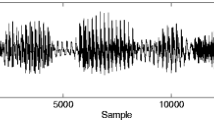Abstract
Some audio watermark schemes robust against desynchronization attacks are based on synchronization code embedded by quantifying signal energy, which have some shortcomings. Such as, (1) they do not verify the authenticity of watermarked signal detected. (2) They are vulnerable to substitution attack. To address the shortcomings and considering the background, a speech content authentication algorithm is proposed in this paper. Firstly, the original speech signal is framed, and each frame is cut into some segments. Secondly, samples of the segments are scrambled, and self-correlation of the scrambled signal is calculated. Lastly, watermark bit generated by frame number is embedded by quantifying the self-correlation. If watermarked signal is attacked, the attacked frames can be detected according to the frame number extracted. Theoretical analysis and experiments demonstrate that the scheme is robust against desynchronization attacks, improves the security, and has a good performance in ability of tampering location.














Similar content being viewed by others
References
Chen OTC, Liu CH (2007) Content-dependent watermarking scheme in compressed speech with identifying manner and location of attacks. IEEE Trans Audio Speech Lang Process 15(5):1605–1616
Djendi M, Scalart P (2014) Reducing over-and under-estimation of the a priori SNR in speech enhancement techniques. Digital Signal Process 32:124–136
Khan LA, Baig MS, Youssef AM (2010) Speaker recognition from encrypted VoIP communications. Digit Investig 7(1–2):65–73
Korycki R (2014) Authenticity examination of compressed audio recordings using detection of multiple compression and encoders’ identification. Forensic Sci Int 238:33–46
Lei BY, Soon IY, Li Z (2011) Blind and robust audio watermarking scheme based on SVD-DCT. Signal Process 91(8):1973–1984
liu ZH, Wang HX (2014a) A novel speech content authentication algorithm based on Bessel-Fourier moments. Digital Signal Process 24(1):197–208
liu ZH, Wang HX (2014b) A speech content authentication algorithm based on pseudo-Zernike moments in DCT domain. Int J Digi Crime Forensics 5(3):13–34
Luo D, Sun MM, Huang JW (2016) Audio postprocessing detection based on amplitude cooccurrence vector feature. IEEE Signal Process Lett 23(5):688–692
Ming J, Crookes D (2014) An iterative longest matching segment approach to speech enhancement with additive noise and channel distortion. Comput Speech Lang 28(6):1269–1286
Muhammad K, Ahmad J et al (2015) A secure method for color image steganography using gray-level modification and multi-level encryption. KSII Trans Internet Inf Syst 9(5):1938–1962
Pun CM, Yuan XC (2013) Robust segments detector for de-synchronization resilient audio watermarking. IEEE Trans Audio Speech Lang Process 21(11):2412–2424
Sajjad M, Muhammad K et al (2016) Mobile-cloud assisted framework for selective encryption of medical images with steganography for resource-constrained devices. Multimedia Tools and Applications. doi:10.1007/s11042-016-3811-6.
Schwerin B, Paliwal K (2014) Using STFT real and imaginary parts of modulation signals for MMSE-based speech enhancement. Speech Comm 58:49–68
Shih PY, Lin PC, Wang JF, Lin YN (2011) Robust several-speaker speech recognition with highly dependable online speaker adaptation and identification. J Netw Comput Appl 34(5):1459–1467
Tabibian S, Akbari A, Nasersharif B (2015) Speech enhancement using a wavelet thresholding method based on symmetric Kullback–Leibler divergence. Signal Process 106:184–197
Vivekananda BK, Indranil S, Abhijit D (2011) A new audio watermarking scheme based on singular value decomposition and quantization. Circuits, Systems, and Signal Processing 30(5):915–927
Waleed AN, Mohsen AMEB (2011) An SVD audio watermarking approach using chaotic encrypted images. Digital Signal Process 21(6):764–779
Wang HX, Fan MQ (2010) Centroid-based semi-fragile audio watermarking in hybrid domain. Science in China Series F-Information Sciences 53(3):619–633
Wang Y, Wu SQ, Huang JW (2010) Audio watermarking scheme robust against desynchronization based on the dyadic wavelet transform. J Adv Signal Process 13:1–17
Wang XY, Ma TX, Niu PP (2011) A pseudo-Zernike moments based audio watermarking scheme robust against desynchronization attacks. Comput Electr Eng 37(4):425–443
Xiang SJ, Huang JW, Yang R (2006) Robust audio watermarking based on low-order Zernike moments. Proceedings of the fifth International Workshop of Digital Watermarking, 226–240
Xiang SJ, Kim HJ, Huang JW (2008) Audio watermarking robust against time-scale modification and MP3 compression. Signal Process 88(10):2372–2387
Acknowledgments
Authors appreciate the support by the National Natural Science Foundation of China (grant No. 61272465, 61502409, 11601465), and Natural Science Foundation of Henan Province (142400410485, 152300410233). We also thank the anonymous reviewers for their constructive suggestions.
Author information
Authors and Affiliations
Corresponding author
Rights and permissions
About this article
Cite this article
Wang, J., He, J. A speech content authentication algorithm based on a novel watermarking method. Multimed Tools Appl 76, 14799–14814 (2017). https://doi.org/10.1007/s11042-016-4027-5
Received:
Revised:
Accepted:
Published:
Issue Date:
DOI: https://doi.org/10.1007/s11042-016-4027-5




